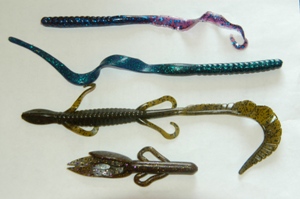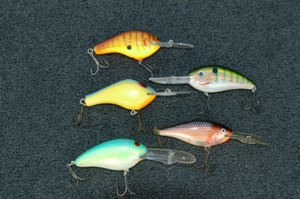Most
every angler among us usually can't wait for warm weather
to hit season after season. Then, once that warmer weather turns into
blazing heat, especially here in the
south, we all start to wonder "Just where did the fish go?" Well,
I'll tell you where they went in one word. Deep! Sure you still
catch a few by beating the banks and even have a good day now and then
on topwater baits, especially early and late in the day. But what about
at high noon when the water temps have surged well over eighty degrees?
And what about at night when that early feeding frenzy has ceased?
Those little green monsters we all hold so near and dear to our hearts
are just like us in a way. They like to find the coolest part of their
environment to hang out in.
 Whether
you're fishing on a mostly shallow lake, a long winding river or
a highland impoundment reservoir, you can bet your bass boat that
when the dog days of summer are upon us, you'll find the bigger
bites in deeper, cooler water. What is considered "deep
water" by us anglers isn't necessarily considered deep
by the fish though. I've caught tons of spotted bass deeper than
forty feet during hot summer months, and I think most consider that
deep to just about anybody's standard in fresh water. I could
go on for days about fishing for spotted bass in deep water, but let's
face it; the majority of anglers don't target spotted bass for
tournament fishing unless they are on a lake that is primarily a spotted
bass fishery, so I'll divide it up just a little and get a largemouth
expert to weigh in with his thoughts.
Whether
you're fishing on a mostly shallow lake, a long winding river or
a highland impoundment reservoir, you can bet your bass boat that
when the dog days of summer are upon us, you'll find the bigger
bites in deeper, cooler water. What is considered "deep
water" by us anglers isn't necessarily considered deep
by the fish though. I've caught tons of spotted bass deeper than
forty feet during hot summer months, and I think most consider that
deep to just about anybody's standard in fresh water. I could
go on for days about fishing for spotted bass in deep water, but let's
face it; the majority of anglers don't target spotted bass for
tournament fishing unless they are on a lake that is primarily a spotted
bass fishery, so I'll divide it up just a little and get a largemouth
expert to weigh in with his thoughts.
"Huge largemouth are known as a primarily shallow water
inhabitants, but seasoned anglers will tell you that the real bucket-mouths
will move out to deeper water to escape the heat during the summer
month's water temperatures. Sure they'll sometimes move
up shallow to feed, but as a rule of thumb you can target deeper waters
for the bigger fish." That's what one of the west coast's
biggest sticks in the game, Gary Dobyns, says his thoughts on summertime
largemouth are. Dobyns favorite deep water lure for summer heat is
a homemade half ounce jig he fishes on a Dobyns DX744 rod. "I
mainly target structure that is offshore and has deep water access
that is at least 25-35 feet deep when the water temperatures are soaring",
he says. Dobyns isn't a beyond beating the heat a bit and hitting
the water at night either. "Throwing a big paddle tail worm is
thirty feet of water is what I'll switch to when the jig isn't
getting bit", said Dobyns. Targeting the ledges close to
deep water is where Dobyns says he'll concentrate on throwing
the big worms when he's looking for that kicker bite that comes
after dark during the summer.
 The
typical southern largemouth bass will spend their days and nights
at a depth of ten to twenty five feet, with an occasional trip to
the shallows to feed on shad and other baitfish. After the spring
pattern ends and all the heat starts up just after the spawn, the
fish don't seem to be shallow anymore and the "angler" is
the one that suddenly thinks the fish have moved way down deep. When
the truth is that the exact same spot that your boat was sitting when
you were spring time fishing is where the fish are now hanging out.
Not fifty feet deep, just ten to twenty five where the water is just
a little cooler. When the water surface temperature reaches the nineties,
as it is now, the temperature around ten to twenty feet is still is
still in the upper seventies or low eighties, which is more than comfortable
for that elusive largemouth.
The
typical southern largemouth bass will spend their days and nights
at a depth of ten to twenty five feet, with an occasional trip to
the shallows to feed on shad and other baitfish. After the spring
pattern ends and all the heat starts up just after the spawn, the
fish don't seem to be shallow anymore and the "angler" is
the one that suddenly thinks the fish have moved way down deep. When
the truth is that the exact same spot that your boat was sitting when
you were spring time fishing is where the fish are now hanging out.
Not fifty feet deep, just ten to twenty five where the water is just
a little cooler. When the water surface temperature reaches the nineties,
as it is now, the temperature around ten to twenty feet is still is
still in the upper seventies or low eighties, which is more than comfortable
for that elusive largemouth.
Georgia's Mike
Bucca is no stranger of probing deep water for summertime bass
either. A year round guide and noted deep water spotted bass specialist,
Bucca says, "The absolute key to catching deep fish in the dog days of summer
on non river impoundment revolves around finding the depth of the thermocline
and structure/cover that intersects it." He says that to be successful
in catching summertime spotted bass you must be just as comfortable
catching suspended fish as you are deep and shallow fish. "Versatility
and sonar interpretation is more crucial among spotted bass anglers
due to the suspending nature of Spots. If you're not comfortable
catching suspended fish, you will always struggle with summertime spotted
bass", he says. Bucca goes for three lures when he's
fishing heated waters for suspended bass. His favorites are small,
heavy swimbaits, Fish Head spins in 1/4 and 1/2 ounce and
jigging spoons ranging from 1/4 to one ounce in size.
Personally, there's one lure that I go to during the daylight
hours when the water temps start to soar, and that's a deep diving
crankbait. Nothing gets a monster bass in the heat of the day
like a deep diving crank. When throwing one of these arm drenching
lures, you can pretty much bet the farm that the next tug on the line
isn't going to be a small one. Huge bass absolutely demolish
these deep diving baits during the heat of the day. It's probably
one of the few baits that will bring out a big bite when the temperatures
are blazing, and the bass metabolism is at its highest point
of the year.
Finding the right areas are a must for these depth searchers.
Long points with cover, creek channels and drop offs are the preferred
areas. Deep structure targets are the mission. Huge bait crashing bass
are the results. Repetitive casts with these dredging baits are a must
and that's where most anglers fall short. These baits will cause
our arms and wrists to ache with the numbers of casts you'll
have to endure, but they will also fill the livewell with great catches
if they are used correctly.
 Finding some offshore structure such as rock or brush piles
and the ends of long points are a must for these deep divers. You'll
also load up the rod with some weight by slinging the big crankbaits
on the edges of creek channels and drop-offs. Spool up with some 10lb
test Toray fluorocarbon while using a Dobyns 805CB rod will help you
endure a long day of hard pulling crankbaits. Some deep running baits
to consider are; Norman DD22, Bomber Fat Free Shad BD7 or a Poe's
Super Cedar 400.
Finding some offshore structure such as rock or brush piles
and the ends of long points are a must for these deep divers. You'll
also load up the rod with some weight by slinging the big crankbaits
on the edges of creek channels and drop-offs. Spool up with some 10lb
test Toray fluorocarbon while using a Dobyns 805CB rod will help you
endure a long day of hard pulling crankbaits. Some deep running baits
to consider are; Norman DD22, Bomber Fat Free Shad BD7 or a Poe's
Super Cedar 400.
And of course
the number one way to boat summertime bass is to chase them deep
at night. When it comes to deep bass at night, there is one lure
choice in this angler's opinion that works night in and night out
and that's what I call a "drop blade spinnerbait".
These spinnerbaits are usually rigged with one Colorado blade and can
sometimes coax big bass into arm breaking strikes after dark. The pure
explosion of a huge bass onto a drop blade is incomparable to just
about any other bait an angler will every tie onto the end of his or
her line. When fished on drops, these spinnerbaits can be either pumped
or slow-rolled down a slope to entice a bone chilling strike from huge
bass that have escaped the heat to the depths.
Whether you choose to chase those little green scaly creatures
during the heat of the day or you want to battle the bugs after dark,
you can always rely on going just a bit deeper when the water temperatures
begin to creep up during the summer months. Simply pick out your favorite
lure and head to the cooler depths that will be holding the bass that
are just waiting on that easy meal of the day.

